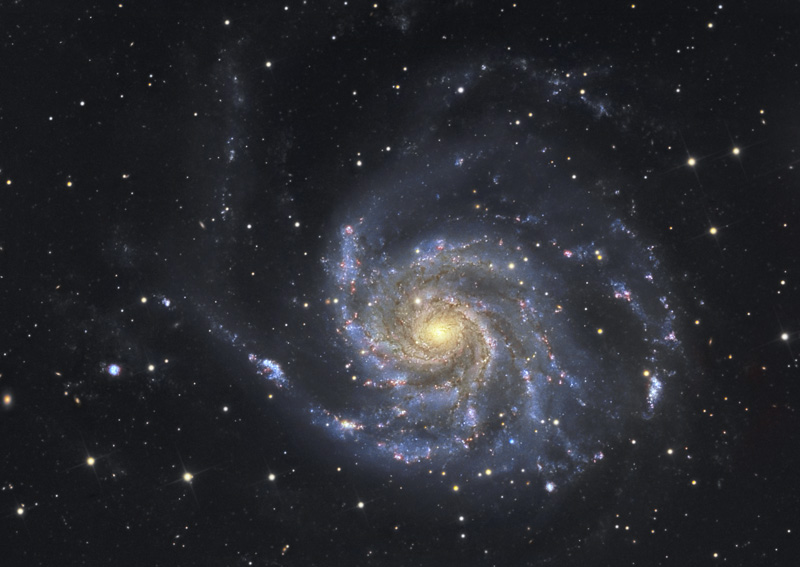Tekija wrote:Why is NGC4725 one-armed (surely not a bandit)?
Why indeed.
M81. Photo: NASA, ESA and the Hubble Heritage Team (STScI/AURA)
M101. Photo: Giovanni Benintende
Galaxies come in so many different shapes. There is a galactic zoo out there.
However, there is a rule of thumb that we can use. Galaxies with large, bright, yellow centers, like nearby M81, basically never have wide-ranging arms. Galaxies with small yellow centers, like M101, often have long, bright, blue arms. NGC 4725 is slightly similar to M81 in that it has a large yellow center.
Any galaxy that has a large yellow center has a lot of mass concentrated in its center. We know that because a bright yellow center must be made up of
enormous numbers of red and yellow stars, which in themselves are typically not very bright. Indeed, most such stars are downright faint. True, there are red giant stars like
Arcturus, whose luminosity in visual light is about 110 times solar, but red giants like Arcturus are actually somewhat rare. Small faint red dwarfs, on the other hand, are extremely common, and they are going to be terrifically numerous in a yellow galactic bulge. But even though they emit so little light, these red dwarfs are "massive for their light output".
Take Proxima Centauri, the most nearby of all stars (after the Sun).
Jim Kaler wrote about Proxima Centauri that it is
18,000 times dimmer than the Sun in visual light! But at 12% of the Sun's mass, it is only about 8.3 times less massive than the Sun! Multiply the mass of Proxima Centauri by 8.3, and its visual light output increases 18,000 times! But increase the
mass of Proxima Centauri 18,000 times, and you get something totally impossible. To the best of our understanding, no star can be more massive than 200-300 solar masses before it blows itself to bits.
So a large bright yellow galactic center contains overwhelmingly large numbers of mostly small faint yellow and red stars, and all these small stars packed closely together contain a truly huge mass. (There is likely a lot of dark matter in the bright yellow galactic center, too.) A large massive yellow center will pull hard on its spiral arms and keep them quite close to the bulge.
Galaxies with small yellow centers contain much smaller central masses, and the arms of these small-centered spirals can range much more freely and farther.
Take another look at today's APOD. NGC 4725 can be described as a galaxy with a blue ring surrounding its yellow bulge and central elongated bar structure. At around 7 o'clock, a spiral arm seems to branch off from the ring. This spiral arm then wraps itself around the galaxy, sticking close to the blue ring, and after a while it grows fainter and fainter. In the end it is very faint, but this arm winds more than one full turn around the galaxy.
However, there are signs of another arm branching off from the ring at about 2 o'clock. I don't really believe that NGC 4725 only has one arm, but its other arm is very faint. Also both arms may be "kept so close" to the bulge and bar area that the arms seem to overlap, at least from our perspective.
Ann
 The Easterbunny Comes to NGC 4725
The Easterbunny Comes to NGC 4725

